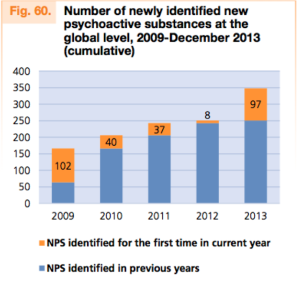Getting High is an Global Problem

Looking at information gleaned from the 2014 World Drug Report suggests two drug trends to expect over the next few years. A bumper crop of opium poppies globally (particularly in Afghanistan), points to an increased worldwide problem with heroin. Afghanistan grew about 80% of the world’s opium poppies in 2013. Second, the development of new psychoactive substances (NPS) has accelerated and doesn’t appear to be slowing down anytime soon. By December of 2013, there were 348 known NPS, an increase of 200% since 2009. There are now more NPS than the number of substances under international control (234).
Globally, an estimated 243 million people aged 15-64 used an illicit drug in 2012. The three primary groups of illicit drugs were: cannabis, opioids, and cocaine or amphetamine-type stimulants (ATS). Generally, men are two to three times more likely than women to have used an illicit substance. While there are regional trends to consider, overall global drug use seems to be stable. The extent of problem drug use, determined by the number of regular drug users and those with drug use disorders, was also stable globally, at around 27 million people. The estimated number of global drug users by drug type is in the table below.
Global Drug Use by Drug Type
|
Cannabis |
Amphetamine-like stimulants |
Cocaine |
Opiates (heroin, opium) |
Opioids (opiates and synthetics) |
||
|
Amphetamines |
Ecstasy |
|||||
|
Users in millions |
177.6 |
34.4 |
19.36 |
17.20 |
16.40 |
33.00 |
|
% of global population 15-64 |
3.80% |
0.70% |
0.40% |
0.40% |
0.40% |
0.70% |
There has been an increase in global opioid and cannabis use since 2009, while the use of opiates, cocaine and ATS has either remained stable or decreased. Reports on the types of drugs individuals seek treatment for can provide information on which drugs have the highest impact on health in the various geographic regions. Cannabis treatment is prevalent in Africa, the Americas and Oceania. It should be noted that between 2003 and 2012 that those seeking treatment for cannabis increased in Western and Central Europe (19% to 25%), Eastern and South Eastern Europe (8% to 15%), Latin America and the Caribbean (24% to 40%) and Oceania (30% to 46%).
Opioids dominate treatment requests in Eastern and Southern Europe and Asia. Cocaine is major treatment factor in the Americas, especially in Latin America and the Caribbean. ATS use disorders are responsible for a significant proportion of the treatment demand in Asia and Oceania.
Global estimates are that one in six problem drug users got treatment in the past year. However, there are large regional differences. One in 18 problem drug users receive treatment in Africa (mostly for cannabis use), while one in five problem users in Europe, one in four in Oceania and one in three in North America receive treatment.
Drug-related deaths were estimated to be around 183,000 in 2012. Overdose deaths from opioids (heroin and non-medical use of prescription opioids) are the main drug type implicated in those deaths. Most overdoses occur when opioids are mixed with other sedating substances, like alcohol and benzodiazepines. See the global data in the table below from the 2014 World Drug Report.
North America continues to be a major market for illicit drug use. It has the largest percentage of opioid users, cocaine users and cannabis users. It was second in percentage of ATS users. Cocaine use has been declining since 2006, partly because of a sustained shortage. Yet there has been a slight increase in prevalence recently. Columbia’s recent decision to stop spraying coca crops could stimulate a greater resurgence in cocaine use.
In the United States, opioid-dependent drug users are increasingly turning to heroin because of its greater availability and lowered cost to regular users. The greater availability of heroin in the United States is likely due to higher levels of heroin production in Mexico and Mexican traffickers expanding into “white heroin” markets. Anecdotal evidence is that Mexican drug cartels are switching from growing marijuana to opium poppies due to the lower demands for marijuana in the United States. See “The Economics of Heroin.”
The rapid growth of NPS has led to a key supply control strategy of restricting the availability of the precursor chemicals necessary to manufacture them. Most drugs, whether they plant-based or synthetic, require chemicals to change them into the final product. While chemical are only one of the components required for the illicit manufacture of plant-based drugs like heroin and cocaine, ‘they constitute the essential components of illicitly manufactured synthetic drugs.”
NPS are found throughout the globe. Of the 103 countries that gave information for the World Drug Report, 94 countries reported the emergence of some kind of NPS in their markets. The increase from August 2012 to December 2013 of newly identified NPS was mostly due to new synthetic cannabinoids (50% of newly identified new psychoactive substances) followed by new phenethylamines (17%), other substances (14%) and new synthetic cathinones (8%). See the following chart from the 2014 World Drug Report.
 Reviewing this report on worldwide drug use reminds me that getting high is an everywhere problem. This year the transition from pharmaceutical painkillers to heroin and the higher cultivation levels of opium poppies suggests a pending increase in heroin addicts and overdose deaths. The rapid explosion of new psychoactive substances onto the drug scene in the past few years feels like a “back to the future” move to the days of patent medicines, when heroin was a cough suppressant and cocaine was a toothache cure. Teething medications contained morphine. Coca-Cola (with cocaine) was a temperance drink and tonic, “a cure for all nervous affections.”
Reviewing this report on worldwide drug use reminds me that getting high is an everywhere problem. This year the transition from pharmaceutical painkillers to heroin and the higher cultivation levels of opium poppies suggests a pending increase in heroin addicts and overdose deaths. The rapid explosion of new psychoactive substances onto the drug scene in the past few years feels like a “back to the future” move to the days of patent medicines, when heroin was a cough suppressant and cocaine was a toothache cure. Teething medications contained morphine. Coca-Cola (with cocaine) was a temperance drink and tonic, “a cure for all nervous affections.”
Cannabis is becoming more potent and toxic just as legalization movements gain steam and increase its use and availability. Coca eradication efforts that seemed to have had an effect on the cocaine market are to be suspended—perhaps leading to a resurgence in cocaine use. Getting high is an everywhere problem and it seems like it’s not going away anytime soon.

